






HMS Hecla
Mined off South Africa
15 May 1942
| BAKER, Harold F, Stoker 1c, D/KX 105375, killed BARKER, Cyril R, Leading Writer, P/MX 81462, MPK COLLARD, William K L, Ty/Leading Supply Assistant, D/MX 80195, killed CROMPTON, Frank, Ordinary Seaman, D/JX 303467, killed ECCLESTON, Harry, Able Seaman, D/JX 193811, MPK FORD, Brian H P D, Signalman, D/SSX 23187, killed GRIFFITHS, Dennis E, Electrical Artificer 4c, C/MX 65788, killed HATCHETT, Harold, Telegraphist, D/JX 191355, killed HOAR, Ernest H, Electrical Artificer 4c, D/MX 66242, killed HOOPER, Horace E, Stoker 2c, D/KX 134284, killed HOSKEN, Leonard C, Supply Assistant, D/MX 68535, killed KNIGHT, Stanley V A, Able Seaman, RFR, C/J 79989, killed |
MARSON, William, Able Seaman, D/JX 219319, killed PERKIN, Harold V, Ty/Leading Supply Assistant, D/X 22, killed ROACH, William J, Act/Joiner 4c, D/MX 70141, killed ROBINSON, Henry, Telegraphist, D/SSX 26621, killed SATTERLEY, Frederick, Able Seaman, D/JX 219846, killed SHAW, David, Leading Wireless Mechanic, 3168 (RNZN), killed STALLWOOD, Sidney J, Stoker, D/K 1752, killed TAGUE, George, Painter 4c, D/MX 67094, killed WANKLYN, Gordon T, Ordnance Artificer (O), P/MX 73376, killed WILLIAMS, Joseph, Writer, D/MX 71097, killed YALLAND, Cyril R, Able Seaman, D/JX 187995, killed YATES, Thomas S, Joiner, P/MX 68058, killed |
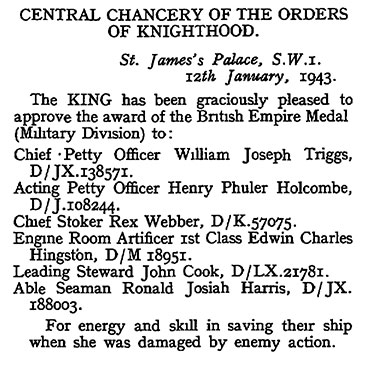
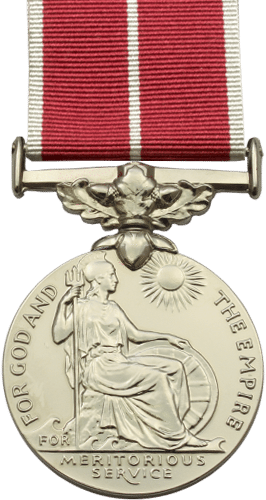
Is a member of your family is on this list? ontact me and I can add further details to their entries on this website:
Chief Petty Officer William J Triggs (BEM) JX138571 MPK
Acting Petty Officer Henry Phuler Holcombe D/J.18244 MPK
Chief Stoker Rex Webber, D/K.57075 MPK
Engine Room Artificer 1st Class Edwin Charles Hingston, D/M.18951
Leading Steward John Cook, D/LX.21781
Able Seaman Ronald Josiah Harris, D/JX.188003
"My best friend aboard Hecla was Ron Harris (JX188003) who got the BEM, lived in Neath, South Wales. Great character, good at sport, all sports", AB James Coulton.
First hand accounts
"We
operated on into the night with bodies on the floor around us. One
sailor had part of his brain protruding and was laid on the floor as it
appeared our efforts would be better on those with more chance to
survive. After a while he raised himself with one arm and asked for a
drink. We got him on the table, did what we could for him. He was still
alive next day, transferred to RNH Simonstown and survived."
The damage to the
ship’s hull was massive. Her survival can be attributed to the very
strict construction standards set by the Admiralty. Despite a 125 ft
tear in its starboard side Hecla made
its way under its own power to the South African naval base of
Simon's Town. Les Proctor described how:
The
following morning, Cyril Hardware and I were sent down to the torpedo
flat to find the bodies of two people we knew to be down there, "Tubby"
Hoare was one and the other was Griffiths. Both had received news at
Freetown that they had become fathers. As the hull plates had been
folded back and were covered with several inches of fuel oil and water,
we were unable to locate the bodies at that time. Our selection for the
job was that we each had sea boots! They They were all
recovered in dry dock, stitched into their hammocks and piled on the
superstructure to await burial. A rather gruesome happening was that I
rushed up a ladder, threw back the curtain that screened the bodies to
find I was looking at the open end of the shrouds (the head end was
left open for identification at burial and to place in a four-inch
shell).
The dead were buried at sea by HMS Gambia.
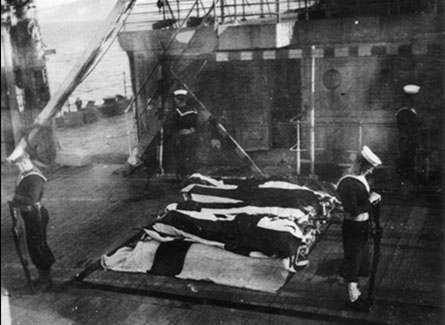
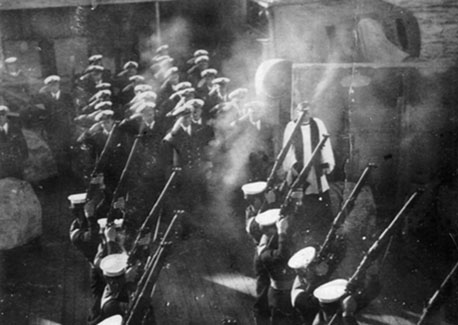
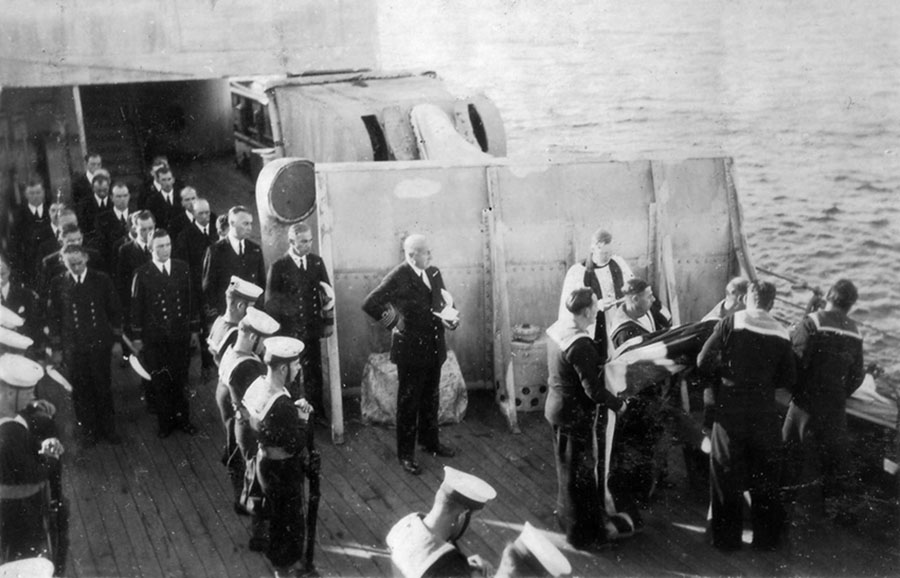
Burial at sea from HMS Gambia
Courtesy of Simon Skelhorne, grandson of Jabez Skelhorne who was killed when HM Hecla sank on 12 November 1942
The mine was laid by the German minelayer, Doggerbank, which was converted from a captured British tramp steamer, the Speybank. On the 3 March 1943 the Doggerbank was mistaken for a British ship by U-43 and torpedoed and sunk west of the Canaries (with 394 killed and only one survivor).
Under repair at Simon's Town, South Africa
May - October 1942
The crew spent
a pleasant five months in South Africa while their ship was under
repair. They "enjoyed all the advantages of a peace time visit to a
truly beautiful country plus the special welcome reserved for service
men by those South African whites who were on the whole still
sentimental about Britain and Royalty and keen to demonstrate that
loyalty" (Ted Coleman). Don Preece and Jabe Skelhorne were two of those whose final months were made the happier by the generous hospitality they received in South Africa.
Edward Coleman
described Simonstown as "quite a pleasing rural community, a few little
shops, a small cinema and a pub or two. The main street included a row
of attractive colonial style buildings more or less opposite the
Dockyard. Admiralty House stood fair and square at the end of the
dockyard complex furthest west from the main gate." He gave an amusing
description of Just Nuisance,
a great Dane officially adopted by the Navy and owner of a regular bed
in the Fleet Club in Cape Town. To find out more about the time HMS Hecla spent at Simonstown, the friendships made and the South Africans who joined the ship for her final voyage click on the link to the South African connection.
Charles Eastop and fifty of his colleagues on HMS Hecla left their ship at Simonstown:
“While she was being repaired fifty or so of her communications staff, wireless and signals, were sent to Mombasa to form a temporary staff for C in C Eastern Fleet who was about to pull out of Ceylon and establish a new base at Mombasa. The intention was for us to return to Hecla on completion of repairs but we were never recalled and consequently Admiralty not knowing the circumstances reported us all missing. Of course we knew nothing of this until some weeks later when somehow the news got thro’ to us and arrangements were made for each of us to send news urgently to our families to say ‘we are safe and well’. It was a great shock to us all to hear such sad news and know that we had lost so many old shipmates – in fact I have never seen a complete list of those who were lost.”
HMS Hecla, now with Capt George Vivian Barnett Faulkner RN (1897-1962) as its CO, was given secret orders to support the Anglo-American invasion of North Africa, Operation Torch.
"In October 1942 Hecla
was deemed to be operational again. We left Simonstown and proceeded
about 100 miles north to Saldanha Bay where we 'hid out' for a week. On
the way into the Bay our navigator missed the boom entrance and took
the boom with us. We sailed back to Cape Town to provision and after a
brief stop over proceeded north en route to Gibraltar to participate,
as a destroyer repair ship in the North African landing." Les Proctor.
George Male thought Hecla
was only sixty percent seaworthy and they were heading back home for
further repairs and the crew stocked up with bananas, unobtainable in
England, during a brief stop over in Freetown. They left Freetown on
the 4 November as part of Convoy CF.7A bound for Liverpool and the last
known photographs of Hecla were taken by Tom Davis, a young rating on the destroyer escort, HMS Active.
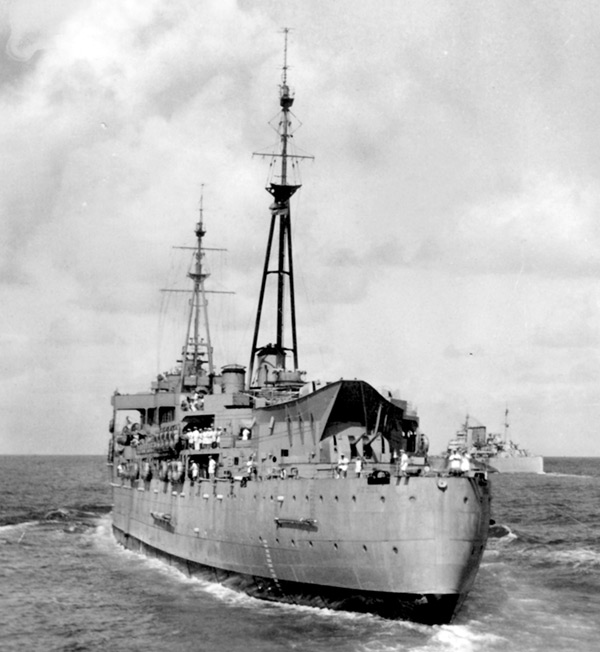
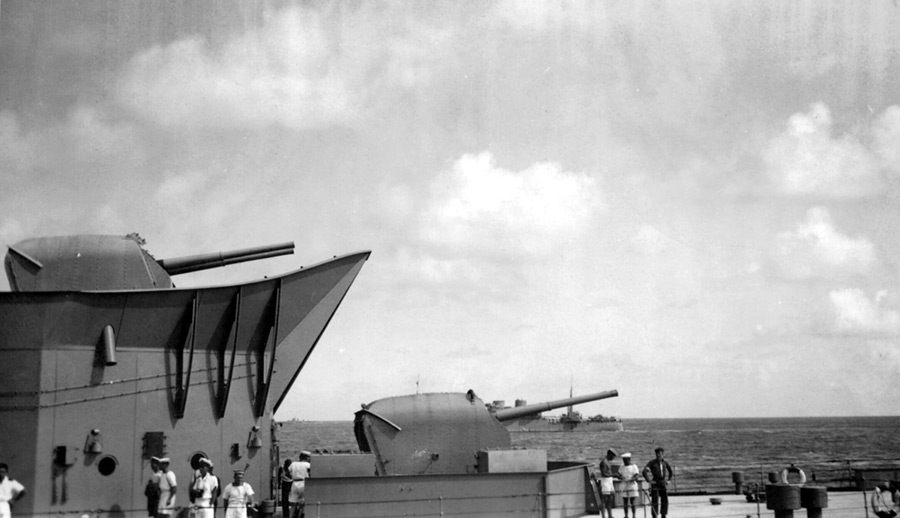
HMS Hecla left Freetown in west Africa as part of Convoy CF.7A and was photographed by Tom Davis. the ships writer on HMS Active
Courtesy of Steve Davis, the stepson of Tom Davis
The two destroyer depot ships, HMS Hecla and Vindictive, were joined by the destroyer escorts, HMS Venomous and HMS Marne,
near the Canaries on the 8 November and detached for Gibraltar to
support the ships taking the troops to the invasion beaches at Algiers as part of
Operation Torch.
At eleven minutes past 11pm on the 11 November 1942 the first torpedo hit Hecla ...
